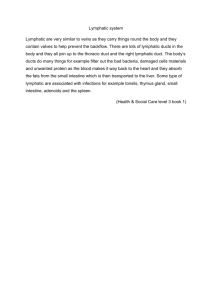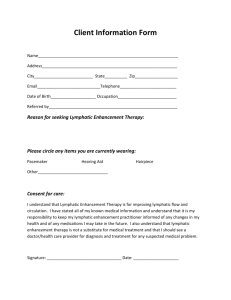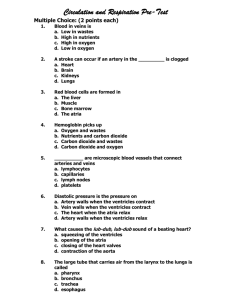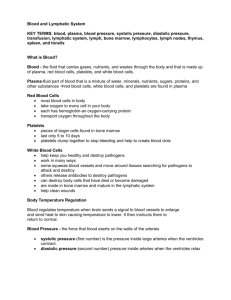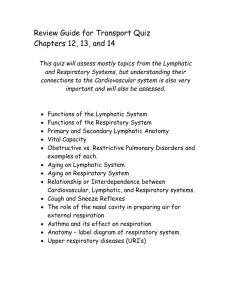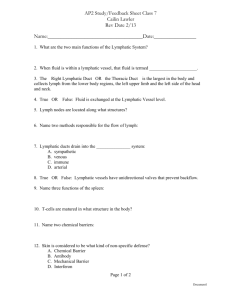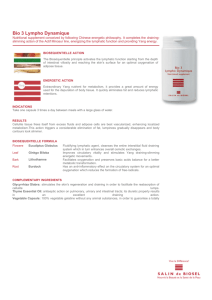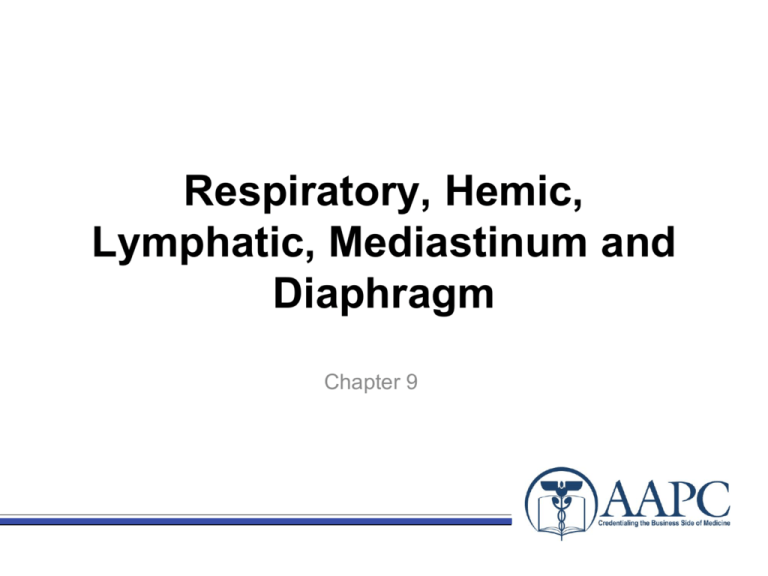
Respiratory, Hemic,
Lymphatic, Mediastinum and
Diaphragm
Chapter 9
CPT® Disclaimer
CPT copyright 2011 American Medical Association. All rights reserved.
Fee schedules, relative value units, conversion factors and/or related
components are not assigned by the AMA, are not part of CPT®, and the AMA
is not recommending their use. The AMA does not directly or indirectly practice
medicine or dispense medical services. The AMA assumes no liability for data
contained or not contained herein.
CPT is a registered trademark of the American Medical Association.
Objectives
• Understand basic anatomy and functions of the
respiratory system, the hemic and lymphatic systems,
and the mediastinum and diaphragm
• Define key terms
• Discuss common CPT® codes and modifiers
• Review diagnoses common to the respiratory system,
the hemic and lymphatic systems, and the mediastinum
and diaphragm
• Introduce HCPCS Level II codes and coding guidelines
as they apply to these systems.
3/18/2016
3
Respiratory System
•
•
•
•
•
•
•
Nose
Larynx
Pharynx
Trachea
Bronchi
Bronchioles
Lungs
3/18/2016
4
Respiratory System
• Alveoli
– Located at the ends of the bronchioles
– Function is gas exchange (CO2 and O2)
• Pleura
3/18/2016
5
ICD-9-CM
• Respiratory System
– Acute Respiratory Infections (460-466)
– Other Disease of the Upper Respiratory
System (470-478)
– Pneumonia and Influenza (480-488)
– COPD and Allied Conditions (490-496)
3/18/2016
6
ICD-9-CM
•
•
•
•
•
•
Laryngitis
Croup
Respiratory Syncytial Virus (RSV)
Pneumonia
Influenza
COPD
3/18/2016
7
ICD-9-CM
•
•
•
•
•
•
Asthma
Bronchitis
Pneumoconiosis
Empyema
Pneumothorax
Interstitial Lung Disease
3/18/2016
8
ICD-9-CM
• Pulmonary Edema
• V codes
– Personal history
– Family history
– Screenings
3/18/2016
9
Rules/Guidelines
• Respiratory procedures
– Progress downward from the head to the thorax
• Parenthetical statements
– Directions on how to use specific codes
– Apply to codes above parenthetical note; not
below
• Most codes are unilateral
• Use modifier 50 if bilateral procedure
performed
– Unless code descriptor states bilateral
The Nose
• Incision
– Drainage
• Abscess or hematoma
The Nose
• Excision
– Biopsy code
– Nasal polyps
• Polyp is a growth protruding from a mucous membrane in a
body cavity
• Simple or extensive
• Use modifier 50 to bill bilateral
• One or multiple polyps removed, report code one time
The Nose
• Excision
– Lesion destruction
•
•
•
•
Approach used
Lasers
Cryotherapy
Electrocautery
– Cyst removals
– Turbinates/procedures
• Soft, small bones in nose
• Can inhibit proper breathing when enlarged/diseased
• Billed per turbinate
– Code up to six turbinate removals
The Nose
• Rhinectomy
– Total rhinectomy
• Remove entire nose
– Deep cancer of skin
– Bad case of frost bite
The Nose
• Introduction
– Therapeutic turbinate injection
– Prosthesis for deviated nasal septum
• Plug placed by physician
• Removal of foreign body
– Office setting
– Facility setting
• General anesthesia
The Nose
• Repair
– Rhinoplasty
• Cleft palate/lip repair
• Parenthetical statement
– Reconstruction, grafts
– Septoplasty, Atresia. Fistulas, Dermatoplasty
The Nose
• Destruction
– Turbinate mucosa
• Do not use modifier 50
• Other procedures
– Control of epitaxis (nose bleed)
• Approach
• Simple or complex
• Use modifier 50 for bilateral on anterior approach
– Fracturing of turbinates
Accessory Sinuses
• Incision
– Open vs closed (or endoscopic)
• Cutting into the body area
– Sinus lavage
– Sinusotomies
• Drainage
• Polyp removal
• Biopsy
Accessory Sinuses
• Endoscopy
-All surgical endoscopies always include a
diagnostic endoscopy
– Diagnostic evaluation
• Includes inspection of nasal cavity, meatus,
spheno-ethmoid recess and turbinates
Accessory Sinuses
• Endoscopy
–
–
–
–
–
Biopsies
Maxillary, ethmoidectomy, sphenoidotomy
Repair of CSF leak (ethmoid region)
With optic nerve decompression
Many parenthetical statements in CPT® for accessory
sinus endoscopies
• Other procedures
– Unlisted procedure codes always end in “99”
The Larynx
• Excision
– Removal of part of larynx, pharynx,
surrounding tissue
• Due to tumor of benign or malignant nature
– Approaches
• laterovertical
• anterovertical
• anter-latero-vertical
The Larynx
• Excision
– Always includes tracheostomy
• Not coded separately
– Neck dissections
• Radical-Remove sternocleidomastoid muscle.
submandibular salivary gland, internal jugular vein,
lymph nodes of later neck, chin and mandible and
also supraclavicular nodes
The Larynx
• Incision
– Emergency endotracheal intubation
– Change of tracheotomy tube
The Larynx
• Endoscopy
– Use of operating microscope or telescope
• Parenthetical statement instructs not to code the
operating microscope
– Direct visualization
• View anatomical structures via bronchoscope
inserted into laryngoscope
– Indirect visualization
• Structures viewed in a laryngoscopic mirrored
reflection
The Larynx
• Endoscopy
– Tumor excision
– Vocal cord injector or stripping
– Biopsies
– Flexible fiberoptic and ridged scopes are used
and have different codes
The Larynx
• Repair
– Stenosis
– Scarring
• Result of burn
– Laryngeal web
• Web of tissue between vocal folds
• Destruction
– Laryngeal nerve – unilateral and therapeutic
Trachea and Bronchi
• Incision
– Tracheotomy, tracheal punctures,
tracheostoma revision
– Tracheobronchoscopy through established
tracheostomy
– EBUS
Trachea and Bronchi
• Endoscopy
– Many bronchoscopy codes
• Use common portion of main or parent code (up to the
semicolon) as the first part of each indented code descriptor
under the parent code
• Bulls eye icon – code includes moderate sedation and is not
reported separately when performed
– Bronchoscopy codes
•
•
•
•
•
Bronchial lung biopsies
Foreign body removals
Stent or catheter placements
Flexible or rigid scopes
Many parenthetical statements
Trachea and Bronchi
• Introduction
– Injection for bronchography
– Aspiration
– Indwelling tube/stent placement for oxygen
therapy
Trachea and Bronchi
• Excision and Repair
– Carinal reconstruction
• Needed after removal of cancer at this site
– Tracheal tumor excision
• Thoracic and intrathoracic
– Stenosis and anastamosis excision
– Injury suturing
– Tracheostomy scar revision
Lungs and Pleura
• Incision codes
– Thoracostomy
• Drainage
• Rib resection
– Thoracotomy
•
•
•
•
Exploration
Biopsy
Hemorrhage control
Cardiac massage
Lungs and Pleura
• Incision
– Pneumonostomy
– Pleural scarification
• Treatment for repeat pneumothorax
– Decortication
• Removal of a constricting layer of tissue from
surface of lung(s)
• Allow for full lung expansion
Lungs and Pleura
• Excision
– Biopsies
•
•
•
•
Percutaneous
Needle
Open
Parenthetical statement directions
– Additional codes for imaging guidance
– Fine needle aspirate
– Pathology evaluation of biopies
Lungs and Pleura
• Removal
– Pneumocentesis
– Thoracentesis
Lungs and Pleura
• Removal
– Total pneumonectomy
• Removal of entire lung
– Lobectomy
• Removal of a lobe or lobes of lung
– Resections
Lungs and Pleura
• Introduction and Removal
– Thoracostomy (chest tube)
• Treatment for pneumothorax and persistent
pleural effusion
• Left in patient for several days
– Stitched to skin
• Use larger tube than used in thoracentesis
Lungs and Pleura
• Endoscopy
– Diagnostic vs. surgical
• Billing both together is “unbundling”
– Results in claim denial
Lungs and Pleura
• Lung Transplantation
– Three steps
• Harvesting
• Backbench
• Insertion
– Live donors
• Rare
• Only one lobe donated
– Cadaver donors
• Most commonly used
Lungs and Pleura
• Surgical collapse therapy/thoracoplasty
– Resection
– Thoracoplasty
• Other procedures
– Lung lavage
– Tumor ablation
– Unlisted - 32999
Pulmonary (94002-94799)
• Ventilator Management
• Other Procedures
– Spirometry
– Pulmonary capacity studies
– Respiratory flow studies
– Pulmonary stress testing
– Inhalation treatment
– Oxygen uptake
– Pulse oximetry
Mediastinum and Diaphragm
• Mediastinum-thoracic cavity between the
lungs that contains the heart, aorta,
esophagus, trachea, thymus gland
• Diaphragm-muscle that divides the
thoracic cavity from the abdominal cavity
3/18/2016
41
ICD-9-CM
• Mediastinum and Diaphragm
– Diaphragm Herniation
– Diaphragmatic Paralysis
– Thymic hyperplasia
3/18/2016
42
Mediastinum
• Mediastinotomy
– Cervical approach
– Thoracic approach
• Excision
– Cyst
– Tumor
3/18/2016
43
Mediastinum
• Endoscopy
– Used for lung cancer staging
3/18/2016
44
Hemic and Lymphatic Systems
• Lymphatic System
– Network of channels
• Carries clear fluid
• Includes lymphoid tissue
– Structures dedicated to circulation and
production of lymphocytes
• Spleen
• Thymus
• Bone marrow
Hemic and Lymphatic Systems
• Lymphatic System (cont)
– Three interrelated functions
• Removal for interstitial fluid from tissues
• Absorbs and transports fatty acids to circulatory
system
• Transport antigen presenting cells to lymph nodes
Hemic and Lymphatic Systems
• Spleen
– Located left side of stomach
– Reservoir for blood cells
– Produces lymphocytes involved in fighting
infection
ICD-9-CM
• Hemic and Lymphatic Systems
– Lymphoma
– Lymphadenitis
– Hypersplenism
– Splenic Rupture
– Leukemia
3/18/2016
48
Hemic and Lymphatic Systems
• Splenectomy
• Code selection based on type
– Total
– Partial
– Total with extensive disease
Hemic and Lymphatic Systems
• Repair
– Splenorrhaphy
• Repair of Spleen
• Reported when a ruptured spleen is repaired
– With or without partial splenectomy
Hemic and Lymphatic Systems
• Bone Marrow or Stem Cell Services
– Bone marrow or blood cell transplant
• Treatment for patients with blood diseases
– Obtained by
» Aspiration
» Bone marrow biopsy
» Bone marrow harvesting
• Allogenic bone marrow
– From close relative
• Autologous
– From the patient
Hemic and Lymphatic Systems
• Lymph Nodes & Lymphatic Channels
– Network of nodes that carry lymph throughout the
body
– Clear fluid containing infection fighting WBCs
– Drainage of lymph node abscess
• Simple
• Extensive
Hemic and Lymphatic Systems
• Lymph Nodes & Lymphatic Channels (cont)
– Biopsy or Excision
• Code selection based on method and location
– Open or needle
– Cervical, inguinal, axillary
– Superficial or deep
– Lymphadenectomy
• Limited – removes only lymph nodes
• Radical – removal of lymph nodes, glands and surrounding
tissue
Hemic and Lymphatic Systems
• Lymph Nodes & Lymphatic Channels (cont)
– Injection Procedures
– Lymphangiography
• To view lymphatic circulation
– Use modifier 50 for bilateral procedure
• Identify sentinal node

